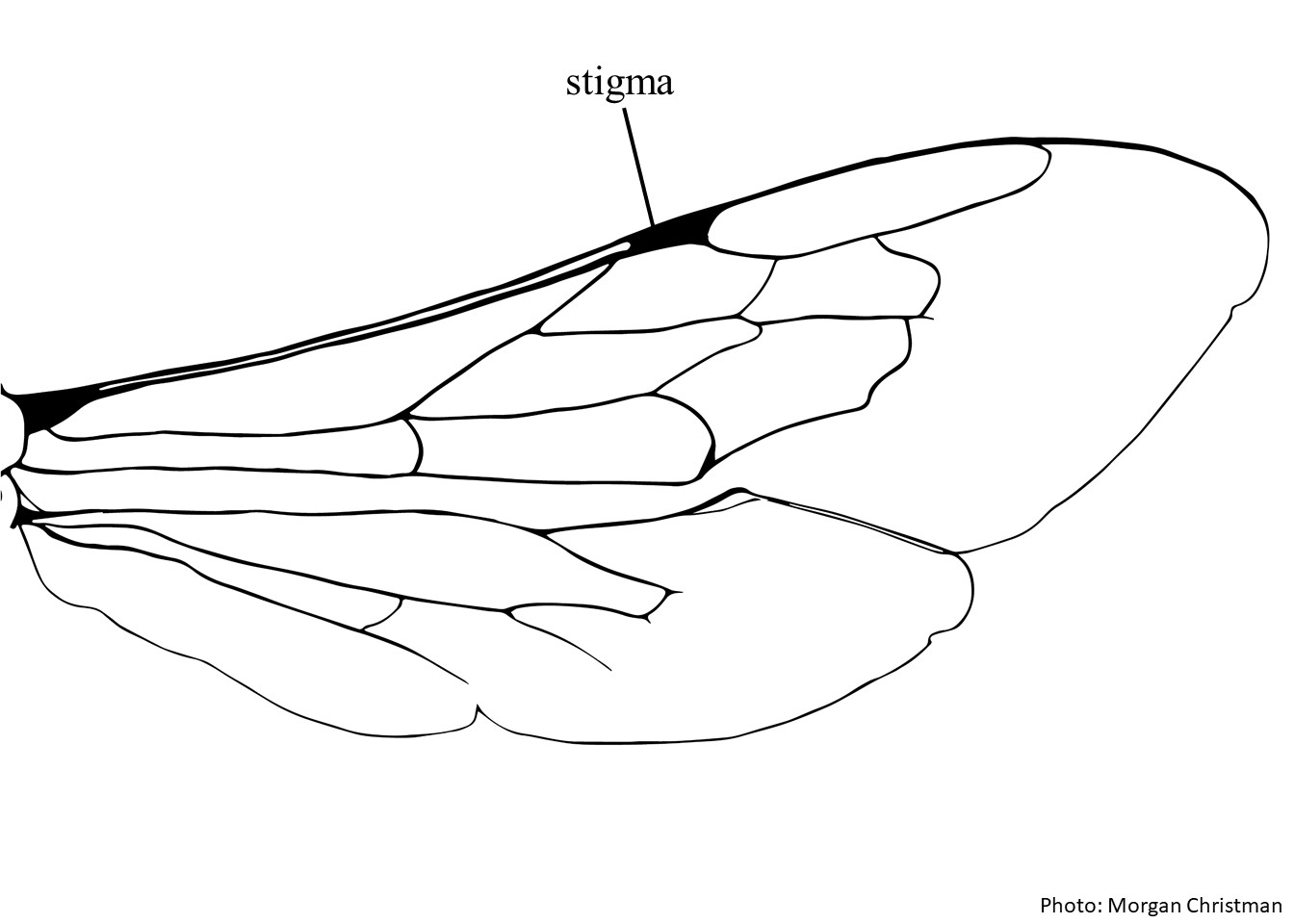Family: Megachilidae
Subfamily: Megachilinae
Tribe: Anthidiini
Genus: Wainia Tkalců, 1980
Subgenera: Caposmia, Wainia, Wainiella
Common name: none
Wainia are black bees that often have apicalapical:
near or at the apex or end of any structure
bands of white hair on their tergaterga:
the segments on the top side of the abdomen, often abbreviated when referring to a specific segment to T1, T2, T3, T4, T5, T6, or T7 . They can be small, slender, and elongate with a body length of 4.5 mm, or large and robust with an almost round abdomen and a body length of 10.5 mm (Michener 2007Michener 2007:
. They can be small, slender, and elongate with a body length of 4.5 mm, or large and robust with an almost round abdomen and a body length of 10.5 mm (Michener 2007Michener 2007:
Michener, C.D. 2007. The Bees of the World (2nd ed.). Johns Hopkins University Press, Baltimore and London, 953 pp.).
Wainia contains 11 species in 3 subgenera (Michener 2007Michener 2007:
Michener, C.D. 2007. The Bees of the World (2nd ed.). Johns Hopkins University Press, Baltimore and London, 953 pp.); none are known to occur in the U.S. or Canada.
(modified from Michener 2007Michener 2007:
Michener, C.D. 2007. The Bees of the World (2nd ed.). Johns Hopkins University Press, Baltimore and London, 953 pp.)
 twice as long as broad or more.
twice as long as broad or more. large, often meeting T6T6:
large, often meeting T6T6: and covering the remaining sternasterna:
and covering the remaining sternasterna: .
. completely invaginated.
completely invaginated.Wainia looks most like Hoplitis and Heriades but can be differentiated by the combination of characters listed above (Michener 2007Michener 2007:
Michener, C.D. 2007. The Bees of the World (2nd ed.). Johns Hopkins University Press, Baltimore and London, 953 pp.).
There are no known invasives.
Wainia have been observed visiting Indigofera sp. (Fabaceae) (Gess et al. 2008Gess et al. 2008:
Gess, S.K., F.W. Gess, and R.W. Gess. 2008. Patterns of usage of snail shells for nesting by wasps (Vespidae: Masarinae and Eumeninae) and bees (Megachilidae: Megachilinae) in Southern Africa. Journal of Hymenoptera Research 17: 86ndash;109.; Kuhlmann et al. 2011Kuhlmann et al. 2011:
Kuhlmann, M., F.W. Gess, F. Koch, and S.K. Gess. 2011. Southern African osmiine bees: taxonomic notes, two new species, a key to Wainia , and biological observations (Hymenoptera: Anthophila: Megachilidae). Zootaxa 3108: 1ndash;24.).
Wainia spp. in the subgenus Caposmia have been found nesting in the empty shells of snails (Kuhlmann et al. 2011Kuhlmann et al. 2011:
Kuhlmann, M., F.W. Gess, F. Koch, and S.K. Gess. 2011. Southern African osmiine bees: taxonomic notes, two new species, a key to Wainia , and biological observations (Hymenoptera: Anthophila: Megachilidae). Zootaxa 3108: 1ndash;24.). Inside each shell, they build one to several brood cells and provision them with pollen. These cells can either be constructed with flower petals or with sand grains that have been cemented together with resins likely collected from plants (Kuhlmann et al. 2011Kuhlmann et al. 2011:
Kuhlmann, M., F.W. Gess, F. Koch, and S.K. Gess. 2011. Southern African osmiine bees: taxonomic notes, two new species, a key to Wainia , and biological observations (Hymenoptera: Anthophila: Megachilidae). Zootaxa 3108: 1ndash;24.). The shells are then plugged using flower petals, followed by a thick layer of cemented sand (Gess et al. 2008Gess et al. 2008:
Gess, S.K., F.W. Gess, and R.W. Gess. 2008. Patterns of usage of snail shells for nesting by wasps (Vespidae: Masarinae and Eumeninae) and bees (Megachilidae: Megachilinae) in Southern Africa. Journal of Hymenoptera Research 17: 86ndash;109.).
Most species are from southern Africa, but 2 of the 11 known species have been found in Israel and east to the Philippines (Michener 2007Michener 2007:
Michener, C.D. 2007. The Bees of the World (2nd ed.). Johns Hopkins University Press, Baltimore and London, 953 pp.).
Distribution map generated by Discover Life - click on map for details, credits, and terms of use.
Gess, S.K., F.W. Gess, and R.W. Gess. 2008. Patterns of usage of snail shells for nesting by wasps (Vespidae: Masarinae and Eumeninae) and bees (Megachilidae: Megachilinae) in Southern Africa. Journal of Hymenoptera Research 17:86-109.
Kuhlmann, M., F.W. Gess, F. Koch, and S.K. Gess. 2011. Southern African Osmiine bees: taxonomic notes, two new species, a key to Wainia, and biological observations (Hymenoptera: Anthophila: Megachilidae). Zootaxa 3108:1-24.
Michener, C.D. 2007. The Bees of the World. 2nd. Ed. Johns Hopkins, Baltimore and London, 953 pp.